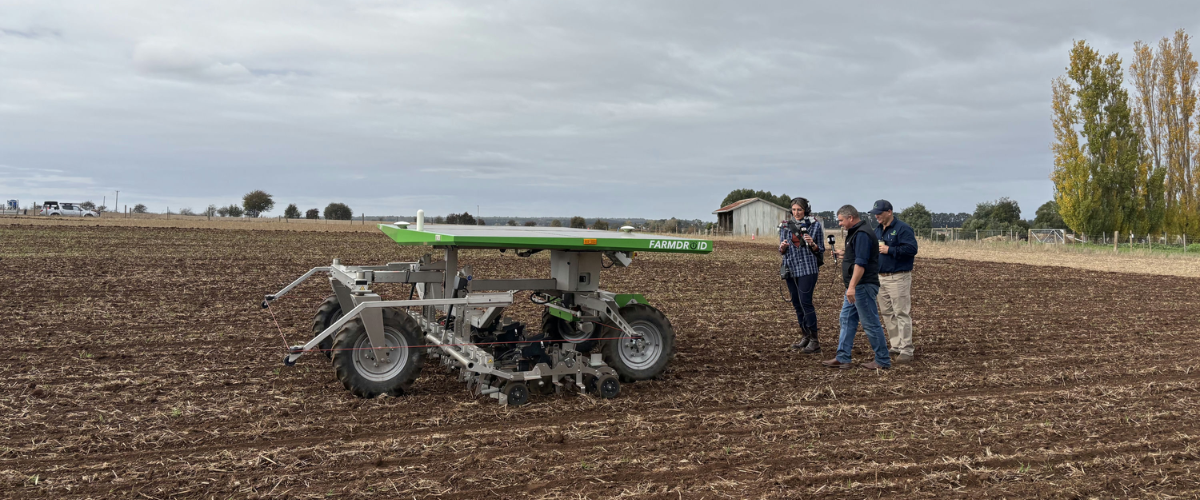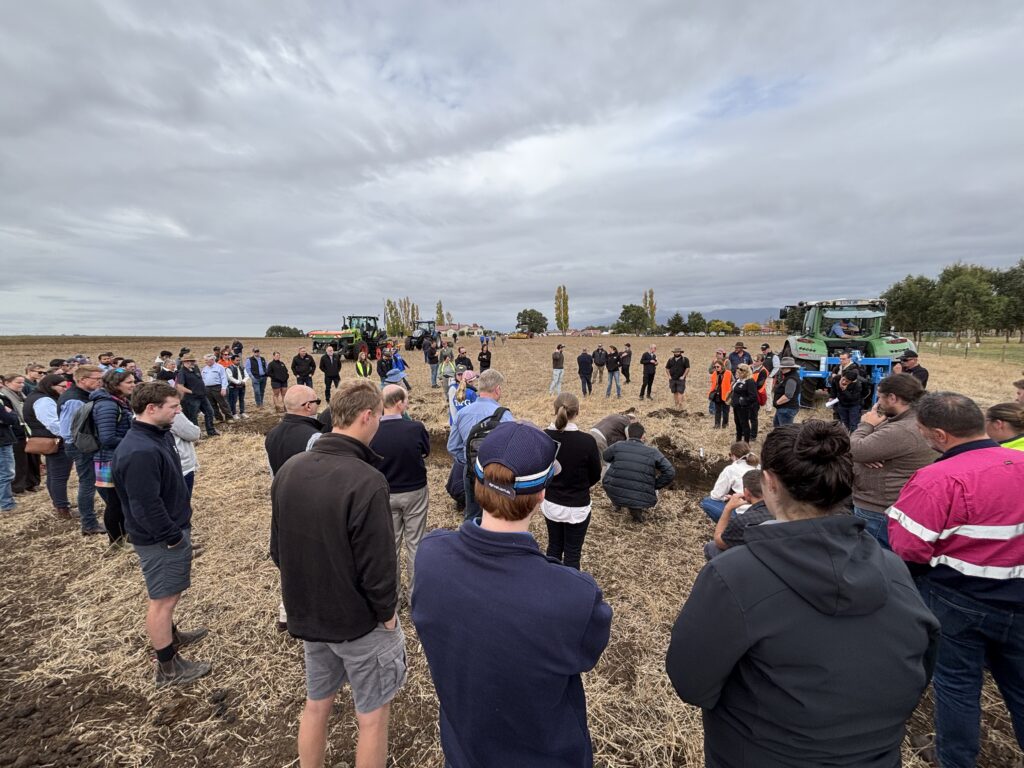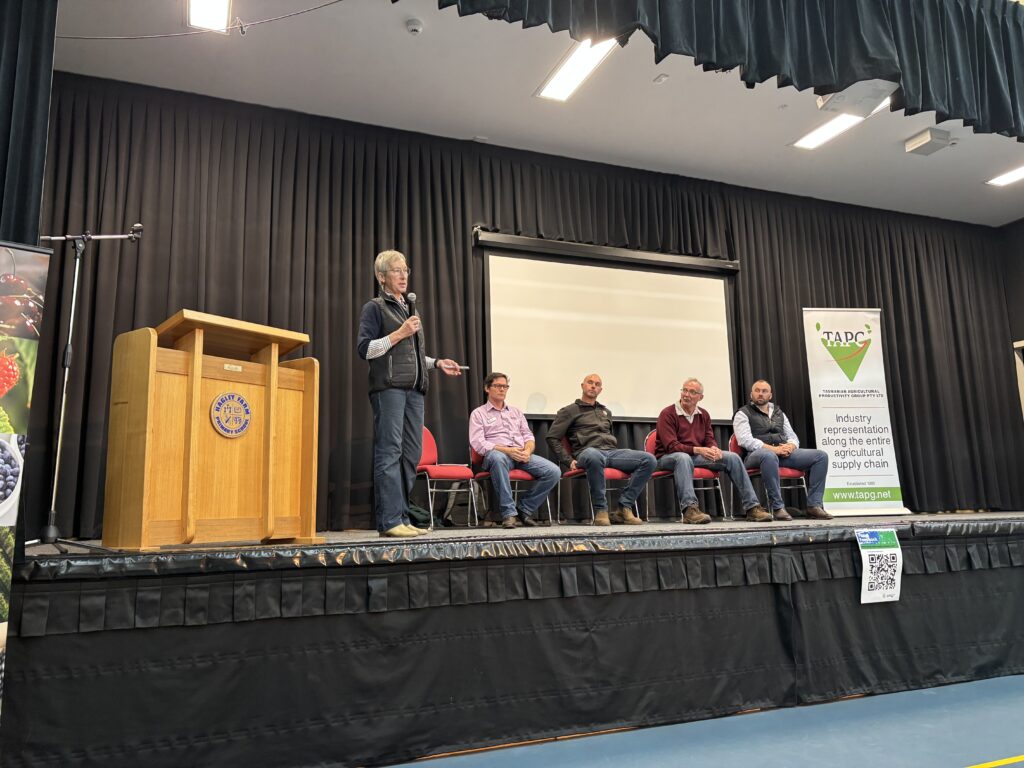
AUSVEG Southeast Asia Trade Mission: Singapore, Malaysia, and Thailand
28 May 2025Resilience, research and regional collaboration shape the future for vegetable growers in South-East Queensland
28 May 2025By Tayla Field and Prue Rothwell, VegNET Tasmania
Held on 15-16 April at Hagley, Tasmania, the Ag Innovation Expo 2025 once again delivered a great opportunity for hands-on learning and collaboration in agriculture. Organised by the Tasmanian Agricultural Productivity Group (TAPG), this year’s theme—Soil Health and Paddock Preparation— drew interest from growers, service providers, educators, students, and ag industry stakeholders.
TAPG Executive Officer Terry Brient highlighted one of the standout moments mof the event: a live soil management demonstration led by UK soil mechanics expert Professor Dick Godwin.
Professor Godwin shared insights into managing soil compaction, highlighting its key impacts on farm productivity:
- Reduced crop yield
- Increased tillage draught force (resistance encountered by tillage tools) and thus fuel use
- Decreased water infiltration due to reduced pore size.
In discussing solutions, Professor Godwin pointed to Australia’s leadership in controlled traffic farming and emphasised strategies such as using track systems, lowering tyre pressure, and reducing machinery weight.
“Prevention is better than cure,” he said, highlighting the need to minimise random traffic, maintain effective drainage, and reduce both load and pressure to preserve soil structure.
Australia is also leading in the use of strip tillage for row crops, especially vegetables, previously showcased by VegNet Tasmania (see more at: ausveg.com.au/knowledge-hub/video-strip-till-in-action-in-tasmania )
Showcasing the FarmDroid autonomous seeder and weeder in action
The event’s twilight VegNET demonstration on 15 April drew more than 60 attendees to explore how drone technology and autonomous machinery can be used in vegetable production. A highlight was a discussion led by VegNET Regional Development Officer Tayla Field with grower James Terry from Cloud Farming, who trialled the FarmDroid autonomous seeder and weeder in North Motton, Northwest Tasmania during the summer.
The North Motton trial was part of the VegMech project (VG23003), a national project delivered through the Queensland Department of Primary Industries (QDPI) to advance mechanisation in vegetable production and reduce labour needs. During the event, Ian Layden, QDPI’s Director of Vegetables, Systems and Supply Chain, and Troy Qualichefski, owner of the trial FarmDroid and Director at Qualipac Farms, joined James Terry for a Q&A session.
Ian reflected on his return to the Expo after first attending 11 years ago.
“Back then, ‘agtech’ wasn’t even part of the conversation. It’s incredible to see how quickly the landscape has shifted—autonomous machines, laser weeders, precision sprayers—these are now commercially viable,” he said.
James reported that after five years of direct seeding broccoli, the FarmDroid delivered his most accurate results to date. It impressed him with its ability to navigate variable paddock conditions, including overcoming obstacles like stubble build-up.
Challenges remain, such as manual switching between seeding and weeding functions and limitations on steeper terrain. However, James believes the benefits—particularly the precision planting and weed control—far outweigh the drawbacks. He’s hopeful the FarmDroid can remain in Tasmania. He can see a use for it in other industries such as pyrethrum production.
In Queensland, Troy planted over 200 acres of broccoli with the FarmDroid last year. New features are on the way, including attachments for planting larger seeds (e.g. sweet corn and green beans) and a smart precision sprayer attachment to further enhance its capabilities.
Ian noted that the return on investment (ROI) from technologies like the FarmDroid isn’t driven by labour savings. Early trial data suggests the real value lies in marketable yield and quality improvements thanks to even plant stands and early weed management.
Drone spraying demonstration
The event also featured a drone spraying demonstration by Octodrones, a new family-run business offering aerial application services across a range of agricultural systems. The demonstration
highlighted the advantages of drone spraying— particularly on saturated or difficult-to-access terrain. The presenters noted that limited registered chemistries for drone application remains a challenge.
For the demonstration, a UV-sensitive paint was mixed with the water spray applied to the crop. This, once viewed under UV light at sunset, revealed excellent coverage delivered via the vortex effect created by the drone’s rotors.
The Ag Innovation Expo hosted three drone operators as exhibitors, highlighting the increase in availability of services on offer for growers in Tasmania, including remote imagery, spraying and fertiliser spreading.
Delving into drivers of onion pack out in Tasmania
After lunch on 16 April, Dr Doris Blaesing of RMCG, who provides technical support to the Onion communications and extension project managed by AUSVEG, led a panel discussion on key factors influencing onion quality and pack-out volumes in Tasmania. The panel included Tim Groom (Charlton Farms & Wynyon), James Burbury (Sumich), Dylan Bellchambers (Harvest Moon), and Ian Layden (QDPI).
Doris opened with the question: What are the essential factors for a successful onion crop?
James Burbury, reflecting on insights from European production systems and export requirements, emphasised the importance of aligning crop programs with market goals—whether targeting fresh or processing markets. He also highlighted the critical role of an appropriate fungicide program and understanding and managing crop vigour.
Dylan Bellchambers pointed to the need for good soil health and balanced soil nutrition from the outset to achieve good bulb quality and overall crop performance.
The panel agreed that field issues during production often carry through to post-harvest storage, markets and export success, making in-field management vital.
Weed control was another major topic. “The crop is growing skinning leaves between the 3-8 leaf stage, and with a range of weed pressures in Tasmania, getting through a compact herbicide program at the right time, before skinning, is crucial,” Dylan said.
Volunteer potatoes were noted as a recurring challenge, requiring management through crop rotation and timely herbicide use.
Ian introduced the concept of alternative weed control technologies, including laser weeders and smart sprayers. With herbicide resistance on the rise, mechanical and precision approaches are becoming essential tools for growers.
Interest is also growing in ultra-high precision spraying technologies like Ecorobotix, which recently arrived at the Queensland Smart Farm for local assessment before being trialled more widely in industry.
The panel then explored post-harvest crop loss which goes to waste.
“You can’t manage what you don’t measure,” Tim noted, highlighting the role of LEAN management in reducing waste at Charlton Farms. Issues like mechanical damage, stones, clods, and weeds at lifting can all impact final pack-out and the volume of out-of-spec onions ending up in waste.
Drainage also emerged as a critical point. Ian shared that underground drainage consistently benefits growers, especially when rain events threaten spray scheduling or seed drilling and establishment. Effective drainage enables timely field access and healthier crop development due to eliminating root damage due to water logging.
Finally, the conversation turned to seed quality. Tim advised that a botrytis test before purchasing onion seed is ideal, though recent supply constraints have limited growers’ ability to test prepurchase. James reinforced the need to plant varieties bred for the local climate, stressing that genetics significantly influence success.
The panel’s key takeaways were to invest in quality seed, ensure strong early establishment, manage drainage and crop inputs carefully, and choose technologies that support long-term productivity.
Looking ahead
The Ag Innovation Expo 2025 was a valuable event for those working in agriculture, offering hands-on experiences, expert insights, and opportunities for connection. Whether it was learning about
soil management practices or cover crops, discovering advanced technologies, or simply catching up with industry colleagues, the event provided plenty of useful takeaways for the agricultural community.
With its practical focus and emphasis on real-world applications, the expo reinforced its role as an important, accessible event in the Tasmanian agricultural calendar.
FIND OUT MORE
Ag Innovation Expo: Tayla Field – taylaf@rmcg.com.au
TAPG: Terry Brient – terry.brient@gmail.com



